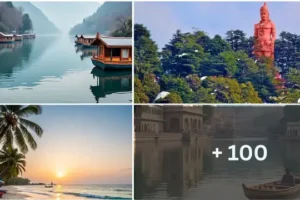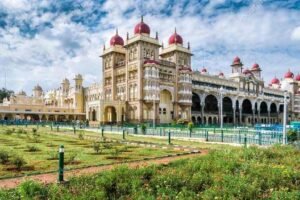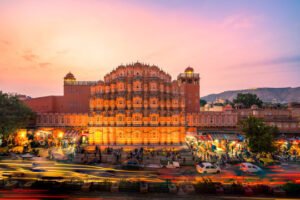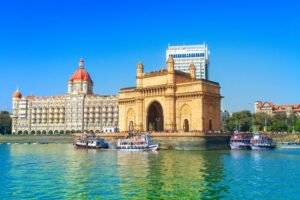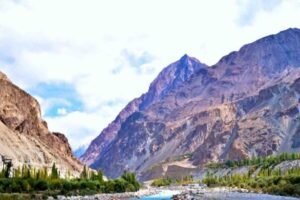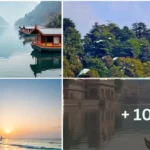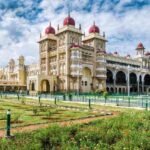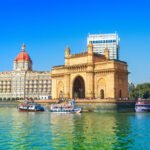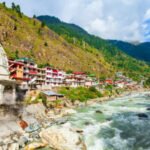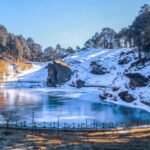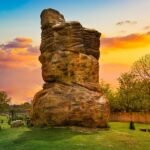Trilokinath Temple Lahaul: The Shine Which Unites Hindus and Buddhists
Trilokinath Temple Lahaul, How to Reach, A Travel Guide 2024: Trilokinath Temple Shrine is so important that is it is considered as most scarred pilgrim thirth next only to Kailash and Mansarover. The uniqueness of the temple lies in the fact that it is the only temple in the whole world where both Hindu and Buddhists pay their reverence to the same deity. The temple is situated in the panoramic Chandra Bhaga valley to the western Himalayas.
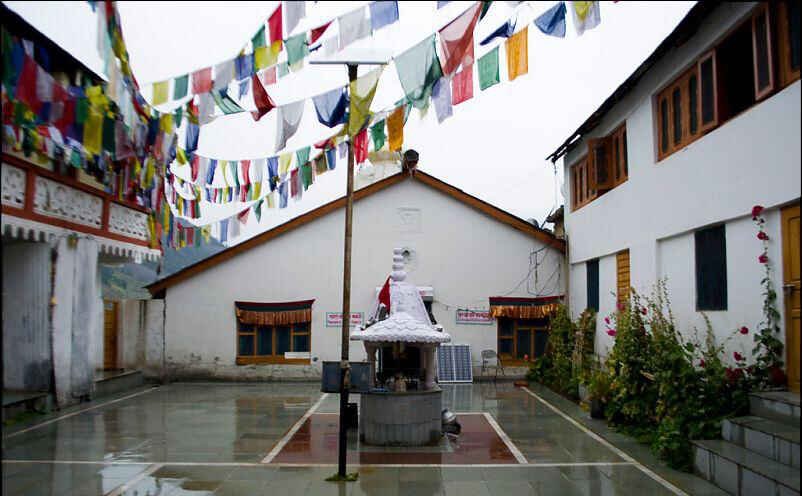
The temple’s name, Trilokinath, translates to “Lord of the Three Worlds,” signifying its significance for both religions. The enshrined deity is a marble idol, with a form that can be interpreted differently depending on your faith. Hindus see it as Shiva, while Buddhists see it as Avalokiteshvara. The idol is crowned with an image of the Amitabha Buddha, the Buddha of Boundless Light, adding another layer of complexity and beauty to the representation.
The Trilokinath Temple is located about 45 kilometers from Keylong, the district headquarters of Lahaul and Spiti, and roughly 146 kilometers from Manali. If you’re traveling through the Lahaul-Spiti Valley, visiting this temple is a must to experience its religious significance and architectural beauty. Just be aware that the roads in the area can be challenging, so plan your trip accordingly.
Trilokinath Temple Lahaul, How to Reach
Spiritual Significance of Trilokinath Temple
The temple is revered by both Hindus and Buddhists. Hindus consider the deity as Lord Shiva, while Buddhists view the same deity as Arya Avalokiteshwar. Tibetan-speaking people refer to the deity as Garja Fagspa. Trilokinath Temple is considered one of the most sacred pilgrimage sites, second only to Mount Kailash and Mansarovar.

Universal reverence:
The name “Trilokinath” itself signifies respect for a supreme being who reigns over all three worlds. This resonates with followers of both religions who believe in higher realms.
Amitabha Buddha:
The crown depicting the Amitabha Buddha adds another layer of meaning. Amitabha is associated with pure land and rebirth, which aligns with concepts of spiritual progress in both religions.
Historical Significance:
Believed to be constructed from a single block of wood by the Pandavas according to local legends, the temple also has architectural significance. Archaeologists believe it reflects the Kashmiri-Kannauj style.
Tranquil Setting:
Nestled amidst the stunning Chandra Bhaga valley and deodar trees, the temple itself exudes serenity and peace, enhancing the spiritual experience.
History of Trilokinath Temple
Trilokinath temple was approximately constructed in the end of 9th century and in the starting of 10th century . Major role was also played by Rajgrana of Chamba Mahayogi Sidh Charpati Dar ( Charpath Nath ). He had unlimited devotion to Bodhisattva Arya Avalokiteshwar and he had composed 25 shlokas in this glory which are called “ Avalokiteshwar strotan Chedem “.

This temple was constructed in the 10th century. It is proved by a stone inscription which was found in the temple complex in 2002 . It is described in this stone inscription that this temple was made by Dvanjra Rana which are beloved to be ancestors of present Rana Thakurs rulers of Triloknath village. They were believed of be helped by King Shell Varman of Chamba who got this temple constructed in “Shikher style” as there are ‘Laxmi Narayan’ temple complex of Chamba. King Shell Varman was the founder of Chamba town.
This is a single temple of Lahaul valley in Shiker Style. Deity of Triloknath Ji is six hundred and lalitasan Lord Buddha is sitting on head of Triloknath. The deity is made up of marble. There is also local story after the manifestation of this deity. It was said that there was a lake on the present Hinsa Nalla.
Seven persons of milky cower use to come out of this lake & drink the milk of grazing cows . One day one of them was caught by Tundu Cowherd boy and was taken to village on his village on his back. There the caught person converted into a marble deity . This deity was established in the temple. This lake is called as “Ome–cho milky ocean” in Tibetan stories.
Local Festival of Trilokinath Temple
There are some local festivals held in the trilokinath temple every year:
- Maker Sakranti- The Abhishekem of the d deity is done with milk . It is locally called uden/utna.
- Halda – It is usually celebrated in the starting week on February. This year it is on 3rd February.
- Fagli – It is usually celebrated after Mahashivratri . This year it is on 19th February. It is sad that fagli of Lahaul is equivalent to diwali as the good news of Lord Sri Ram reaching Ayodhya after killings of exile in forest reached Lahaul on this date by a crow Treta Yuga .
- Baishaki – It is on 14 April this Year .
- Yor –It is usually celebrated in td moth of March. It is celebrated by local Thakurs with other villagers in the village of Triloknath
- Bhyarzee – This festival is celebrated after a pan of 2 years . It is usually celebrated in the month of July . In this festival the devotee goes to the starting point of the Saptdhara.
- Pori Mela – this is a yearly event & a big District level fair is orginsed in the Triloknath temple and in the village . The local Thakurs take the horse of Triloknath Jee to the starting point of Saptdhara and it is believe that they bring Triloknath Jee back to the temple on this horse . Devotee took their holy bath in the Saptdhara . After Pauri Mela group of devotee to Manimehesh lake in Bharmour of Chamba through the Kugti Pass and some of them return back after taking dip in the holy lake through Kali Chho Pass.
How to Reach Trilokinath Temple
By Road:
- If you’re coming from Delhi, you can take a car and follow the AH1 and AH2 routes. The distance is approximately 410kms.
- Alternatively, if you’re already in Lahaul, you can travel to Trilokinath from Keylong (about 45 km away) or from Manali (about 146 km away) by road.
By Bus:
- Himachal Tourism buses connect Trilokinath Temple to Keylong. Buses heading to Udaipur also stop at Trilokinath. You can reserve a seat on these buses or take a cab from Keylong.
- If you’re in Pangi Valley, you can reach Udaipur from Killar (Chamba district), and then proceed to Trilokinath.
By Helicopter:
- During the winter months, when the Rohtang Pass is closed, you can reach Trilokinath Temple by helicopter from Chandigarh or Shimla. However, this is the more expensive option.
Important things to keep in mind:
- Lahaul Valley is located at a high altitude, so it’s important to acclimatize yourself before visiting Trilokinath Temple. Spend a few days in Keylong or another lower altitude destination before making the trip to the temple.
- The weather in Lahaul Valley can be unpredictable, so be sure to pack warm clothes, even in the summer months.
- There are limited accommodation options in Lahaul Valley, so it’s best to book your stay in advance, especially if you’re traveling during peak season.
Here are some additional tips for reaching Trilokinath Temple:
- If you’re not comfortable driving yourself, you can hire a taxi or jeep from Manali or Keylong.
- There are also HRTC buses that run between Keylong and Trilokinath Temple.
- The best time to visit Trilokinath Temple is from May to June or September to October, when the weather is pleasant.
- The temple is open from 6:00 AM to 8:00 PM.
Best Time to Visit Trilokinath Temple
Plan your visit around August when the Pauri Festival takes place at the temple. During this colorful regional festival, both Buddhists and Hindus gather to celebrate the festivities together.
- June (Summers): Alpine flowers bloom, potato fields thrive, and water channels create a spellbinding landscape.
- July – August (Monsoon): Witness the milky waters of Hinsan Nala due to limestone deposits.
- September – Mid October (Autumn): Enjoy pleasant weather and vibrant foliage.
Frequently Asked Questions
Who is God of Trilokinath?
Ancient name of Triloknath temple is Tunda Vihar. This is holy shrine is revered equally by Hindus and the Buddhists. Hindus consider Triloknath deity as “Lord Shiva” while the Buddhists consider the deity as “Arya Avalokiteshwar” Tibetan language speaking people called him as “Garja Fagspa”.
In which district is Trilokinath Temple?
The Sri Trilokinath ji Temple (tibetan Garsha Phagpa གར་ཞ་འཕགས་པ) is in a village of same name 6 km south of the left bank of the Chandrabhaga or Chenab River, and about 9 km from the village of Udaipur, in the Lahul and Spiti District of Himachal Pradesh, India.
Who is Trilokinath?
Lord Shiva is regarded as Triloknath. Because he is master of all the Three realms of this world.
How tall is Trilokinath Temple?
At an altitude of 2760 metres, the beautifully white-painted temple could be seen at the end of the street in Trilokinath village.
What is the history of Trilokinath Temple?
It is believed that Sultan Devi, queen of Raja Ajber Sen, in the 16th century, commissioned the construction of the Trilokinath temple, which was built around 1520 AD. The Sena dynasty who built this temple are believed to have come from Karnataka who settled in Bengal by taking over the declining Pala Empire.
